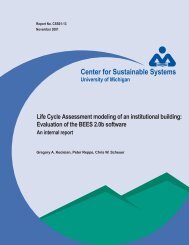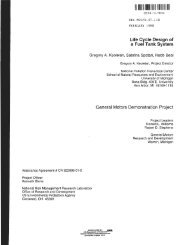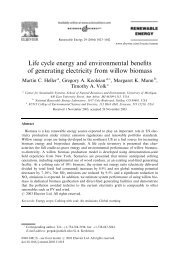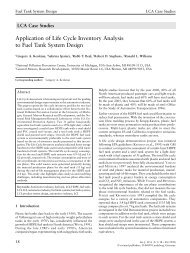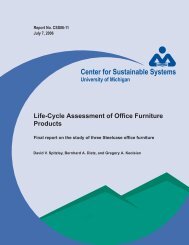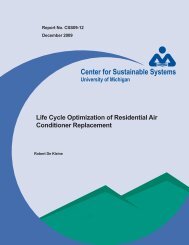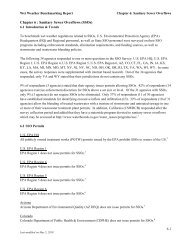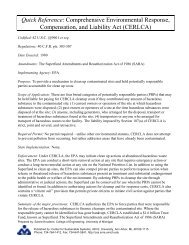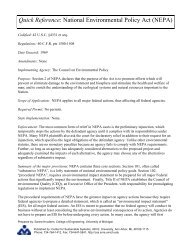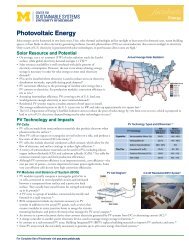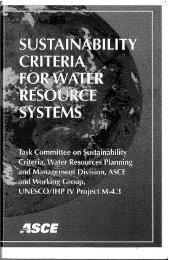A Life Cycle Assessment of the PureCell Stationary Fuel Cell System ...
A Life Cycle Assessment of the PureCell Stationary Fuel Cell System ...
A Life Cycle Assessment of the PureCell Stationary Fuel Cell System ...
- No tags were found...
You also want an ePaper? Increase the reach of your titles
YUMPU automatically turns print PDFs into web optimized ePapers that Google loves.
Inventory Tables<br />
The inventory tables show which data are used in <strong>the</strong> SimaPro model, giving a<br />
transparent view <strong>of</strong> what assumptions are made and where <strong>the</strong> data gaps are. Also, <strong>the</strong><br />
calculations that were necessary to obtain certain data are described. First <strong>the</strong> steel data<br />
and processing data are described separately because <strong>the</strong>y appear in almost all <strong>of</strong> <strong>the</strong><br />
<strong>Pure<strong>Cell</strong></strong> subsystems/components inventory tables.<br />
Steel Data<br />
Approximately two thirds <strong>of</strong> <strong>the</strong> total weight <strong>of</strong> <strong>the</strong> <strong>Pure<strong>Cell</strong></strong> system is made up <strong>of</strong> steel<br />
(carbon steel and stainless steel). In fact, steel is used in almost all <strong>of</strong> <strong>the</strong> <strong>Pure<strong>Cell</strong></strong><br />
subsystems/components. Therefore <strong>the</strong> steel data are described separately here. Three<br />
different types <strong>of</strong> steel are used in <strong>the</strong> <strong>Pure<strong>Cell</strong></strong> system, and <strong>the</strong>y appear in <strong>the</strong><br />
inventory tables as:<br />
• Steel cold rolled coil IISI<br />
• Stainless Steel 304 2B IISI<br />
• Stainless Steel 316 2B IISI<br />
These steel data do not come from a SimaPro database, but are provided by <strong>the</strong><br />
International Iron and Steel Institute, IISI [8]. IISI data are used in this LCA because<br />
<strong>the</strong>y are reliable and up-to-date. The data include <strong>the</strong> recycled input <strong>of</strong> steel scrap into<br />
<strong>the</strong> steel manufacturing process. However, <strong>the</strong> ‘recycling credit’ is not included in <strong>the</strong>se<br />
data. ‘Recycling credit’ is a methodology developed by <strong>the</strong> International Stainless Steel<br />
Forum (ISSF) in order to include <strong>the</strong> benefit <strong>of</strong> making more recycled material available<br />
for future use. The number to be assessed is obtained by <strong>the</strong> following formula:<br />
• Recycled material released for new use at end-<strong>of</strong>-life – (minus) Recycled material<br />
used during manufacturing [9].<br />
Because <strong>the</strong> recycled material released for new use at end-<strong>of</strong>-life is not defined for <strong>the</strong><br />
<strong>Pure<strong>Cell</strong></strong> system, and because subsystem/component reuse will also be part <strong>of</strong> <strong>the</strong><br />
<strong>Pure<strong>Cell</strong></strong> system end-<strong>of</strong>-life scenario, <strong>the</strong> ‘recycling credit’ is not included in <strong>the</strong> steel<br />
data for this LCA.<br />
Processing Data<br />
In most <strong>of</strong> <strong>the</strong> inventory tables, data on material processing appears. Except for <strong>the</strong> <strong>Cell</strong><br />
Stack Assembly (CSA), all subsystems and components were manufactured at an external<br />
supplier’s facility. All <strong>the</strong> material processing data are <strong>the</strong>refore based on personal<br />
interviews with UTC Power and modeled using <strong>the</strong> generic SimaPro databases.<br />
Manufacturing Phase<br />
For <strong>the</strong> SimaPro model, <strong>the</strong> <strong>Pure<strong>Cell</strong></strong> system is divided into a number <strong>of</strong> subsystems<br />
and components, as shown in Figure 4-2.<br />
21



